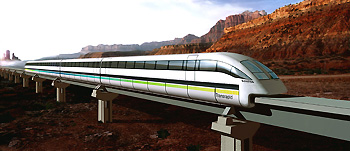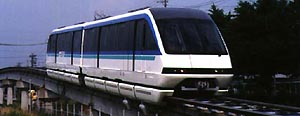Maglev Monorail
A new breed of monorail is being developed. It is still a young enough technology that there are more questions than answers. How capable is it and is it too expensive to build? There is currently great interest in maglev. The Monorail Society recognizes the great progress that maglev developers have made in recent years. We look forward to seeing maglevs in operation so promoters will have a chance to back up their claims of maglev's advantages with statistics from real revenue operations. Will maglev prove itself to be an economic success and change ground transportation? We should have the answer in the 21st Century. While the story unfolds, we are watching with great interest.

Graphic courtesy of Transrapid
Will maglev prove itself to be an economic success and change ground transportation? We should have the answer in the 21st Century. While the story unfolds, we are watching with great interest.
The Federal Railroad Administration defines Maglev as "an advanced technology in which magnetic forces lift, propel, and guide a vehicle over a guideway." So what is a Maglev Monorail? Simply put, maglev monorail follows the guideway as conventional monorail does, but powerful magnets provide propulsion and lift. With most maglevs, there are no wheels touching the track surface, the train "floats" instead of rolling. There are different types of maglevs in development. The Monorail Society focuses on those that use a guideway that is narrower than the train, as is the case with conventional monorail. We use the term "maglev monorail" as opposed to maglev to draw a distinction from systems with large trough-like guideways.
Why Maglev Monorail?
Imagine a train that doesn't touch its track and think of the potential for lower guideway maintenance costs as a result. Imagine a train that speeds along much faster than anything on the highway with a ride as smooth as silk. Imagine that train being capable of speeds higher than any other ground-based transportation system. Maglev can provide this speed and compete directly with airline travel. As stated by American Maglev, "Maglev means magnetically levitated and propelled vehicles.

Photo courtesy of Chubu HSST Development Corp.
The advantage of maglev is that it can achieve very high speed and acceleration/deceleration performance because the vehicles essentially "fly" at very low altitudes - unlike trains or cars, there is no surface contact or "friction" to slow them down. More speed = more passengers." Only when we have real revenue-producing systems in operation will be able to prove whether this is true or not.
The real advantages of maglev appear to us to be of city-to-city corridors, longer than urban rail systems where stations are only a mile or so apart. Yet there are companies that think even short distances can be served well by maglev as well. Time will tell whether this is true. We anxiously await full-scale systems being implemented so we can see for ourselves. Conventional monorail is proven, maglev monorail is still in its development stage. Test tracks exist, but revenue-producing maglev systems aren't in operation yet. That makes the burden of proof tougher for maglev proponents. We wish them well and look forward to seeing the mode advance successfully.
Learn more about maglev trains on Wikipedia's maglev page.
